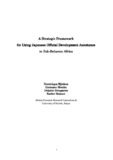| dc.identifier.citation | Njinkeu, D. D., Mwabu, G., Rwegasira, D. R., & Gesami, R. A(21999). strategic framework for using Japanese official for using Japanese official development assistance development assistance in Sub-Saharan Africa. PP. 1-69 | en_US |
| dc.description.abstract | Foreign aid in Africa is at a crisis stage. The economic literature is divided
on usefulness of aid in Africa, and some research in this area has argued for its
curtailment, falling short of recommending cancellation. Amidst this controversy,
Japan has substantially increased its development assistance in Africa. Over the
period 1994-98, Japan gave development grants and loans to some 20 SubSaharan
African countries regularly. There is need, therefore, to examine the
effectiveness of this aid in reducing poverty, and in supporting sustainable
development.
There is an emerging consensus that foreign aid may be an effective
instrument for sustainable development and for improving the plight of the poor
in countries with good policy environments. A good policy environment comprises
macroeconomic stability; incentives for investment, accumulation and for
participation in local and international markets; social inclusiveness; a viable
social infrastructure (public utilities, transport and communications, rule of law);
decentralized governance, and a political system supportive of economic reforms.
However, research has not provided guidance on how to achieve good policy
environments.
Reforms to change policy environments have in the past been directed
towards aid recipients. It is argued in the report that aid policies of donors need to
be changed also, to realign them with needs of beneficiaries. Thus, a good policy
environment is broadened to include desirable elements of donor policies as well.
Lack of research information on how to create good policy environments, under
which to deliver assistance to the needy, is one reason why aid in Africa has not
been effective in reducing poverty or in initiating sustainable growth.
The report argues strongly that foreign assistance in itself is not bad for
African development. It finds no sound basis for calls to reduce aid, other than the
economic hardship of donors. The root cause of aid ineffectiveness in Africa is joint
failure of African governments and donors to design and implement viable
systems of delivering assistance to the poor. Existing top-down mechanisms for
aid delivery in Africa leak substantial aid to non-poor, and tend to create or
perpetuate dependency.
Another principal argument in the report is that reform of policy
environments and aid delivery systems is not sufficient for aid effectiveness. A
further condition is that aid must be allocated and used strategically if it is to
reduce poverty on a sustained basis; or, if it is to create an environment for doing
so.
As to strategic allocation, donors and governments can play a critical role in
directing aid to broad sectors of the economy where it is likely to have the greatest
payoffs, both in terms of human development, and in terms of stimulating
economic growth. In Africa, where the development of human resources is
exceedingly low, there are large benefits from investing aid resources in education,
health care, AIDS prevention and cure, and in water and sanitation facilities.
Outside the social sectors, additional resources from foreign aid can be invested in
agriculture – to provide for food security and promote production of high value
farm exports; in industry – to create opportunities for high wage employment and
to lay the foundation for industrialization; in regional integration institutions – to
enhance regional markets and diffusion of technology; in civic institutions – to
create conditions for social inclusiveness in the development process; and in
research – to build capacity for generating development ideas locally.
As to strategic use of aid, this can be achieved at local levels by involving
communities in the delivery of emergency aid – to ensure its proper targeting; in
identification of projects to be funded with aid money – to avoid irrelevant
investments; and in operations of aid-supported projects – both to build
management capacity via learning-by-doing, and to promote local ownership of
the projects.
Poverty in Sub-Saharan Africa is so generalized that it is unrealistic to
expect foreign assistance to turn around the living conditions of the people in a
few years. Thus, aid policies of donors should take a long-run view of needs and
development priorities of the region. Moreover, given the diversity of the continent,
uniform reforms or aid delivery systems cannot be expected to work well in every
country. Aid policies and delivery mechanisms have to be country specific. Thus,
background information on potential beneficiaries should inform aid policies.
The main thrust of the report is that development cannot be taken to a
country via foreign aid. Development must come from within a country through
design and implementation of locally owned and sustainable programs. Foreign
aid is to be seen as a mechanism for facilitating, accelerating, or just supporting
country-driven development initiatives. The priority areas for JODA support
identified in the report include education and health; agriculture development
(including rural non-farm sector); physical infrastructure in rural and urban areas,
especially the facilities needed for new information and communication
technologies; research & development activities; institutional reforms; and
regional integration programs, especially that fall under the umbrella of NEPAD
(New Partnership for Africa’s Development) | en_US |

